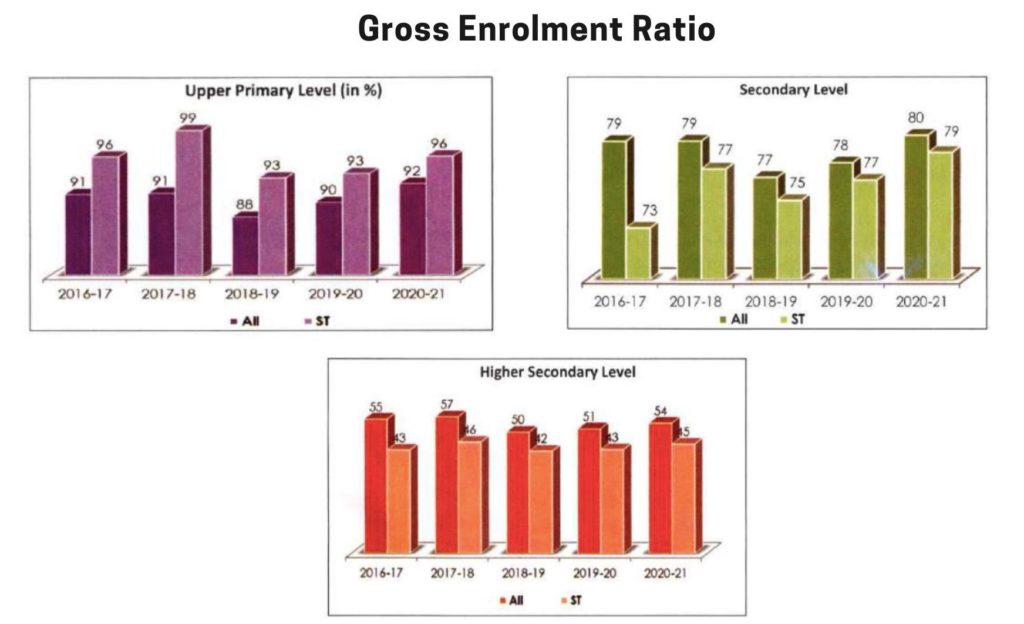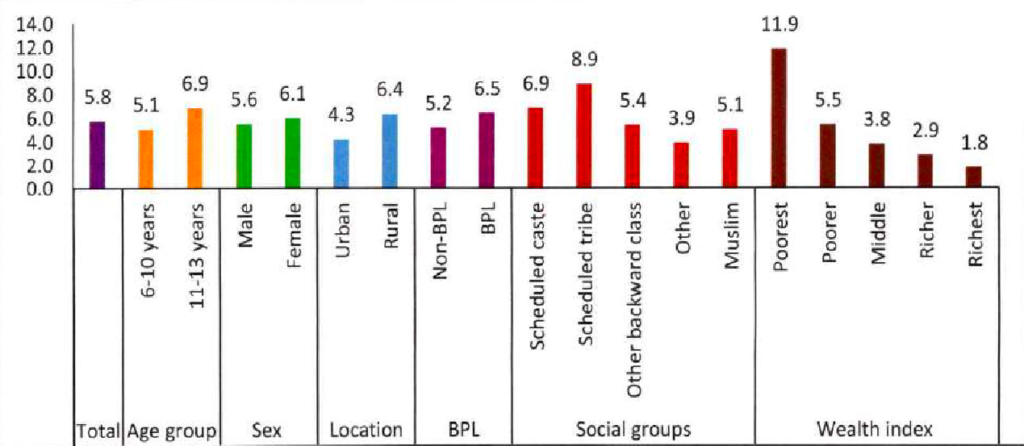ForumIAS announcing GS Foundation Program for UPSC CSE 2025-26 from 19 April. Click Here for more information.
Contents
| For 7PM Editorial Archives click HERE → |
Introduction
The aim of any education system is to ensure inclusive and equitable quality education at all levels of school education. An inclusive education system ensures that no child loses any opportunity to learn and excel because of the circumstances of birth or background. To ensure inclusive education for tribals, the Ministry of Education and Ministry of Tribal Affairs have been implementing various schemes relating to education, health, economic empowerment, etc. in the Scheduled Tribe dominated areas of the country. Many schemes are implemented with specific target of uplifting the education amongst tribal communities.
About Tribal Education Status
According to the 2011 Census, Scheduled Tribes (notified by the Government of India under Article 342 of the Indian Constitution) constitute 8.6% of the total population. There are 705 Scheduled tribes living in different parts of India and are notified in 31 States/UTs (Census 2011).
There is direct correlation between education and economic growth but this impact are evident only after certain period of time as the impact might not be ascertainable immediately. The government has formulated a number of schemes for the socio-economic development and adopted a tribal sub-plan. Education was conceived as a means for promoting the overall development of the tribes and also adopted as a strategy for mainstreaming them.
Source: Kurukshetra. Literacy rates of Scheduled Tribes continue to be lower than that of all communities. It was 59% against national literacy rate of 73%.
The Gross Enrolment Ratio (GER) of tribal students has improved over the years. Analysis has shown that the GER for ST students is above the national average for the last 5 years at primary and upper primary level. However, it starts decreasing at secondary and senior level.
Source: Kurukshetra. The major challenge is high dropout rate at secondary level. GER for STs is higher at primary level but lower than average for all communities at secondary and higher secondary level. This indicates higher dropout rate among ST Communities.
Genesis of Educational Policies and their Focus on Tribal Education
After independence various commissions were constituted to study, review, analyse and recommend the desired contextual changes in education system. The first university education
| Education Commissions/Committees formed by the Government of India | |
| Name | Recommendation |
| Scheduled Areas and Scheduled Tribe Commission (1961) | Educating the tribes in vernacular language with the support of trained teachers from the tribal communities. Promoting tribal culture and arts, by adding folklore, songs, etc. in the curriculum. Identified the basic issues related to the educational backwardness of tribal communities and the drop-out of the students leading to formation of new tribal education policies. |
| National Education Commission (1966) (Kothari commission) | Supported the recommendations and suggestions of Debar Commission. Noted the importance of the need for promoting parental education among tribal population, and early childhood learning. |
| 2nd National Policy on Education (NPE) (1986) | Vision to remove the disparities, inequality and to bring educational opportunity for all. Gave more priority to the promotion of tribal education, such as the establishment of primary schools in tribal areas; address the need for starting Model Residential Schools including Ashram Schools for tribal students in the country; starting Anganwadis in tribal hamlets, etc. |
| Review of NPE (1990) | Highlighted the issue of removing disparities in education by stating that “the rural areas in general and the tribal areas in particular, have suffered in terms of resources, personnel and infrastructure facilities”. Recommended special earmarking for girls within the special component plan for Scheduled Castes and Tribal sub-plan. |
Various Programmes/Schemes on Education
The RTE Act: With the 86th Amendment to the Constitution Article 21A was inserted to ensure that every child has a right to full time elementary education of satisfactory and equitable quality in a formal school satisfying certain norms and standards. This subsequently resulted in formulation of the Right of Children to Free and Compulsory Education (RTE) Act, 2009 which gave a legal mandate to provide free and compulsory elementary education to every child in the age group of 6-14 years.
Samagra Shiksha Scheme: Department of School Education and Literacy (DoSEL), Ministry of Education is implementing the Samagra Shiksha scheme, effective from 2018-19. Its objective is to bridge gender and social category gaps at all levels of school education. The Scheme reaches out to girls, and children belonging to SC/ST, Minority communities and Transgenders.
Under Samagra Shiksha, there is a provision of Kasturba Gandhi Balika Vidyalayas (KGBVs). KGBVS are residential schools from class VI to XIl for girls belonging to disadvantaged groups such as SC, ST, OBC, Minority and Below Poverty Line (BPL). At present 4,986 KGBVs are functioning in the country with an enrolment of 6.69 lakh girls. Preference are given to Educationally Backward Blocks (EBBs), LWEs, Special Focus Districts (SFDs) and the 115 aspirational districts.
The Central Sector Scheme ‘National Means-cum-Merit Scholarship Scheme‘ has objective to award scholarships to meritorious students of economically weaker sections to arrest their drop-out at class VIll and encourage them to continue the study at secondary stage.
Ministry of Tribal Affairs has been implementing various schemes relating to education, health, economic empowerment, etc. in the Scheduled Tribe dominated areas of the country.
Eklavya Model Residential School (EMRS): EMRS are targeted to be established in every block having more than 50% ST population and at least 20,000 tribal persons (as per census 2011). These EMRSs are to be at par with Navodaya Vidyalayas with special facilities for preserving local art and culture besides providing training in sports and skill development. The scheme has target to establish 740 schools. At present out of 684 schools sanctioned, only 378 schools have been made functional with an enrolment of 1.05 lakh students.
National Fellowship and Scholarship for Higher Education of ST Students: The scheme provides financial assistance for pursuing MPhil and PhD in Universities and for perusing graduate and post graduate courses in top 246 Institutes like IIT/AIIMS etc.
National Overseas Scholarship (NOS) to the ST Students for Studies Abroad: Under the Scheme, financial assistance is provided to 20 ST students every year for pursuing higher studies abroad.
Pre-Matric Scholarship: Pre-Matric Scholarship Scheme is a Centrally Sponsored Scheme under which financial assistance is provided to ST students studying in classes IX and X.
Post-Matric Scholarship: Post-Matric Scholarship Scheme is a Centrally Sponsored Scheme under which financial assistance is provided to ST students studying beyond class X.
Support to Tribal Research Institute (TRI): This scheme aims to strengthen TRIs to carry out research, documentation, training and capacity building activities and serve as a knowledge hub catering to overall tribal development. Tribal museums are also established under this scheme.
Development of Particularly Vulnerable Tribal Groups (PVTGs): This scheme adopts a habitat level development approach to improve the quality of life through intervention in housing, drinking water, education and health services, livelihood support, and cultural aspects.
Major Challenges for Tribal Education
In the case of Scheduled Tribes, the remoteness of habitations, lack of travelling facilities, insufficient infrastructure facilities, illiteracy of parents, communication problem, and segregated population are the primary constraints for the educational attainment.
Lack of Adequate Infrastructure in Schools: Adequate infrastructure which include gender segregated functional toilets, pucca school buildings, electricity, water, play area, library, sports facilities, and safe and conducive environment for learning are the primary requirements for retaining a child in the school. The tribal areas are generally remote, hilly and in dense forests, therefore, schools located in these areas lack such facilities. These issues ultimately lead to children dropping out of school.
Source: Kurukshetra. Proportion (%) of children aged 6-13 years not attending school, 2019-21, NFHS-5
Low Learning Level of Children: Despite the Right to Education Act and other schemes for promoting quality education, the learning levels of children remain poor. This problem is not limited to only tribal children but entire education system. The recently released results of National Achievement Survey (NAS) 2021, indicate that only 42% children at Grade Ill are proficient in all subjects which decrease to 23 percent in class X. Further disparity among social groups widens strikingly at grade Vill and grade IX.
Medium of Instruction: It is a well established fact that primary education in mother tongue has huge benefits. Various studies have established the benefits of mother tongue language development in contexts where multiple languages are used for a variety of purposes. Own language learning has beneficial effect on other language learning and teaching. In a country like India that occupies multiple cultures and languages, one language dominating learning and education as a medium of instruction can leave many illiterate and foster unproductive learning. The struggle between mother tongue and dominant language in classroom leaves the aspiring learners from the Scheduled Tribes behind in learning.
Lack of Teachers and Appropriate Pedagogy: Schools in far flung areas and difficult terrain face shortage of teachers. Many primary schools have single teacher and that teacher is not aware about the needs of tribal students. Due to communication gap, tribal students are termed as slow learners. Further, teachers should adopt play based and activity based pedagogy to make learning interesting so that children do not find education irrelevant. Real life application of knowledge and respect for tribal knowledge may make a huge difference in educational outcomes of the Students.
Way Forward
First, The National Education Policy 2020 reaffirms that bridging the social category gaps in access, participation, and learning outcomes will continue to be one of the major goals of all education sector development programmes. It recognises the challenges faced by the tribals communities at multiple levels. To ensure inclusion of marginal communities in quality educational space of India, the NEP 2020 proposed the policy strategy to identify Special Education Zones (SEZs). The SEZs will be the identified regions where significantly large populations from educationally and socio economically disadvantaged groups reside.
Second, The next step could be to preserve and assimilate tribal knowledge in curriculum framework. It will ensure that quality education not only is accessible to all diverse groups but also is relevant and connected with their traditions, aspirations and needs. NEP 2020 puts special emphasis on Indian Knowledge Systems, including tribal knowledge (tribal ethno-medicinal practices, forest management, traditional (organic) crop cultivation, natural farming etc.), and indigenous and traditional ways of learning.
Third, multilingual education and instruction in mother tongue as envisaged in Article 350A of the constitution (which provides for facilities for instruction in mother tongue at the primary stage) need to be promoted in big way . The RTE Act and NEP 2020 also propagates mother tongue as medium of instruction wherever possible
Fourth, As per NEP 2020, special attention may be given to employing local teachers or those familiar with local languages. Teachers need to be trained, encouraged, and supported with continuous professional development. The availability of local teachers will resolve two issues simultaneously; i.e. availability of teachers and communication gap between teachers and students.
Conclusion
As envisaged in NEP 2020, universal access to quality education to all children is the key to India’s continued ascent, and leadership at the global stage in terms of economic growth, social justice and equality, scientific advancement, national integration, and cultural preservation. Ensuring quality education is going to be the most fundamental requirement as India embarks on its journey to become a developed nation in the Amrit Kaal period. Bridging education gaps should be the top priority of the Government in this period.
Syllabus: GS II, Welfare schemes for vulnerable sections of the population by the Centre and States and the performance of these schemes, Issues relating to development and management of Social Sector/Services relating to Health, Education, Human Resources.
Source: Kurukshetra September 2022







